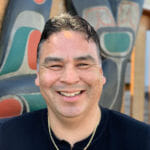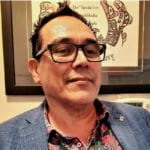The Mamalilikulla Guardians are re-asserting the Nation’s presence in their territories, conducting research and restoration, monitoring industrial and recreational activity, and protecting cultural assets. With the Nation’s 10-year stewardship vision, they are mapping a path forward to do even more.
Mamalilikulla Guardian Watchmen: Fulfilling Ancestral Responsibilities for the Benefit of Future Generations
Estimated Reading time

49 Mins
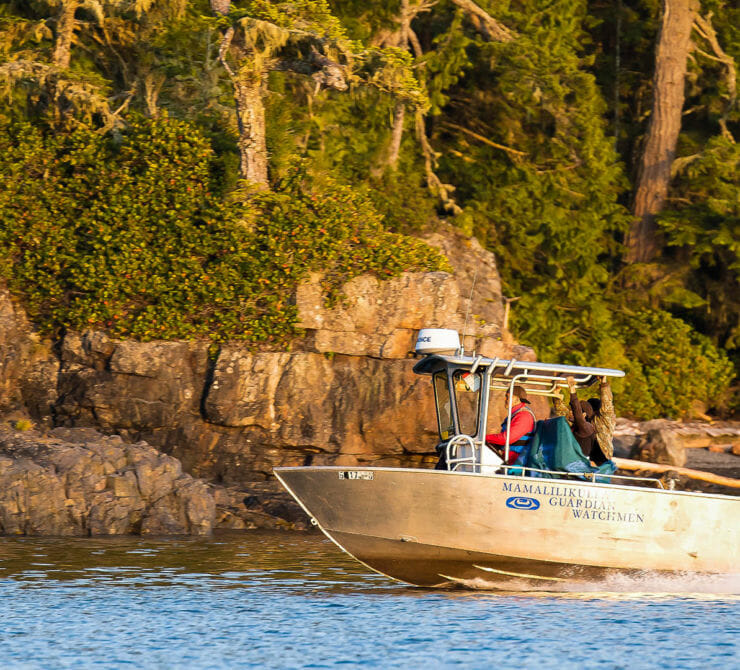
‘Mimkwa̱mlis Village Island is the heart of the Nation’s territory. ‘Mimkwa̱mlis was historically the main winter village for the Nation, and it is the place of the Mamalilikulla creation story.
At a Glance
The practice of maya’xala, a Kwak’wala word meaning “respect,” is a guiding concept for Mamalilikulla First Nation. Practicing maya’xala is a commitment to fulfilling their ancestral responsibility to steward the lands, waters, and animals of their territory as they have done for thousands of years.
The Mamalilikulla Guardian Watchmen program is one way in which the Nation is fulfilling that responsibility and resisting centuries of colonial impact. Over six years of operation, the Guardians have reasserted a strong presence on their lands and waters. They monitor recreational and industrial activity, conduct research and restoration work on marine and terrestrial species, and undertake public communication and outreach. The Guardians are more than the Nation’s “eyes and ears,” they are stewards, actively caring for and restoring the well-being of their homelands for the benefit of current and future generations of Mamalilikulla.
In the short time since the program was established, and with limited access to self-determined stewardship funding, the Guardians have made significant positive impacts in their territory. But there is much more the Nation would like to accomplish. In 2020, Mamalilikulla First Nation documented its 10-year stewardship vision, outlining its commitment to grow its stewardship authority. Today the Nation is fundraising to fulfill that vision and has set itself on a path to uphold Mamalilikulla’s inherent rights and responsibilities to practice maya’xala.
A Thriving, Forward-Thinking, Progressive Nation
“It is our responsibility to steward our territory in a manner that supports our natural resources, sustains our people, and enhances the public respect for our marine, terrestrial, and cultural resources that has been lacking in recent decades.” – Former elected Chief Councillor Richard Sumner
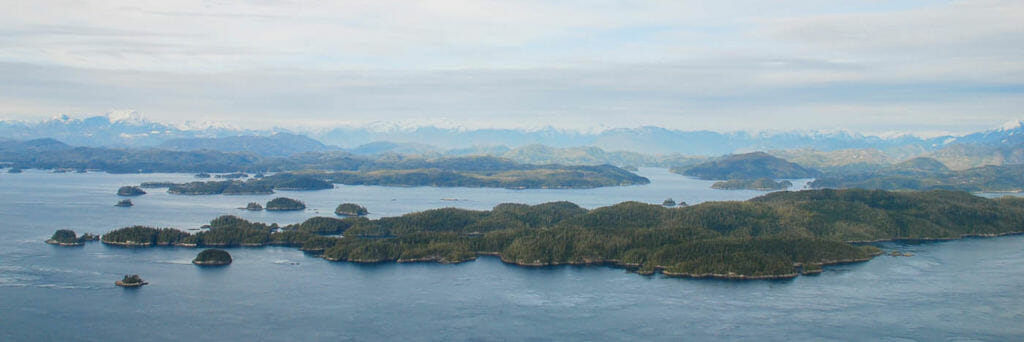
The traditional territory of Mamalilikulla First Nation is in the heart of what is today known as the Broughton Archipelago, an area renowned for its rich cultural and ecological diversity. Their territory lies between the north-east coast of Vancouver Island and the mainland of British Columbia, extending from Matsui Creek and ‘nalaxdłala Hoeya Sound in Knight Inlet, through Black Fish Sound, into Johnstone Strait. It includes, among others, Compton, Gilford, and Village Islands.
But the heart of the Nation’s territory is ‘Mimkwa̱mlis Village Island. ‘Mimkwa̱mlis was historically the main winter village for the Nation, and it is the place of the Mamalilikulla creation story. It is here that the creator gave a blind man sight and the name Mama̱liliḵa̱la. He then built a house at the place called Two-Headed on ‘Mimkwa̱mlis, and from that time until 1972 the village was occupied by Mamalilikulla First Nation, the descendents of Mama̱liliḵa̱la.
Leading up to 1972, the long, painful arm of colonialism pushed Mamalilikulla citizens from their ancestral home. “It goes back into the early 1900s when children were taken away and brought to residential schools,” says Jake Smith, a Mamalilikulla hereditary Chief and the manager of the Nation’s Guardian program.
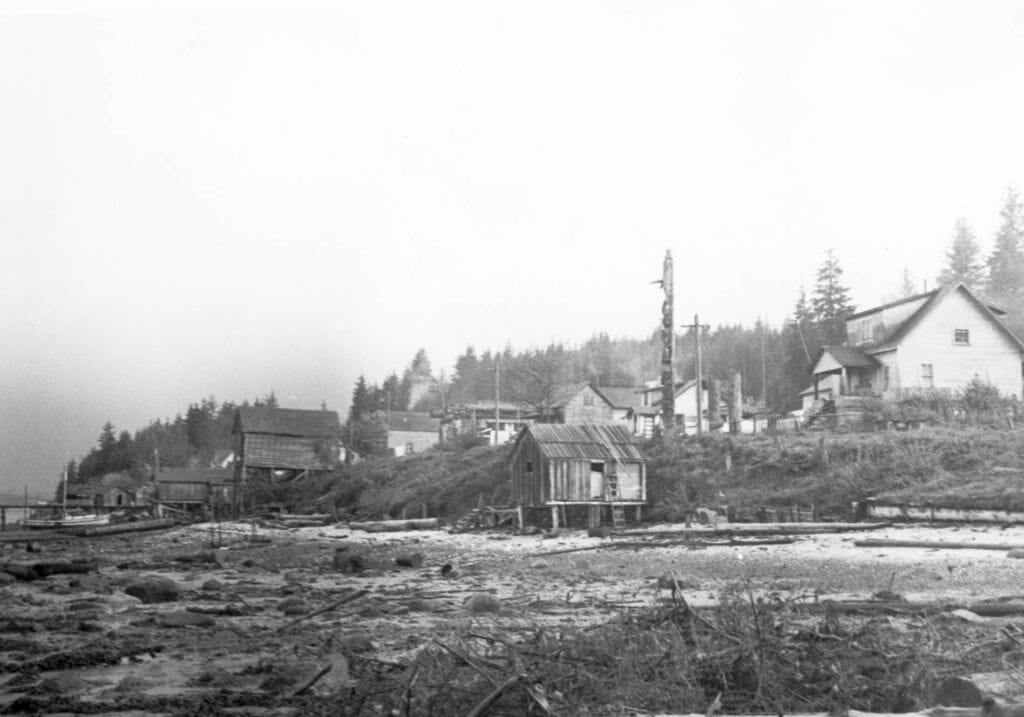
Between the residential schools that separated children from their families and their culture, and the Potlatch ban that made cultural and political practice illegal, the people who lived on ‘Mimkwa̱mlis found no reason to stay on the Island. “Elders that lived there slowly moved away,” says Smith. “They couldn’t teach their children. They had nothing to pass on to their children.”
When the people of ‘Mimkwa̱mlis left their territory, they settled in communities and cities across the province, including Port Hardy, Campbell River, Victoria and Vancouver. For a long time, separation from their lands and waters coloured the Nation’s ability to fulfill its ancestral stewardship responsibilities and prevented them from benefiting from much of the economic activity taking place in their territory.
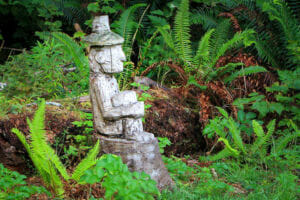
“For a long time, we didn’t have eyes and ears in our territories, the way many Nations do,” says John Powell, Chief Councillor of Mamalilikulla First Nation.
But the Nation is whole, and they are actively resisting the legacy of colonization.
“People think we’re some sort of lost and forgotten people,” says Richard Sumner, former elected Chief Councillor of Mamalilikulla First Nation. “We’re not. We’re a thriving, forward-thinking, progressive Nation that is directly involved with our lands and resources in a number of ways.”
We’re a thriving, forward-thinking, progressive Nation that is directly involved with our lands and resources in a number of ways.
In 2016, when Mamalilikulla Nation won the right to elect their own leaders following a lengthy court case, Sumner was compelled to run for Chief Councillor in the election.
In the five years he was Chief Councillor, Sumner led the Nation through many successes. “We started with nothing,” Sumner recalls “No staff, no money, no work plan. Nothing.” But today, the Nation has all of that and much more. It is on a path to self-determination, a path to uphold their inherent rights and responsibilities. A critical element of that path is the Nation’s stewardship vision and Guardian Watchmen program.
A Guardian Program to Support the Nation’s Sovereignty and Leave a Legacy of a Well-Cared for Territory
“The Guardian program, and the stewardship of our land and the protection of our territory is paramount.” – Chief Councillor John Powell
When Richard Sumner was elected Chief Councillor in 2016, the Mamalilikulla Guardian program was still in its infancy. “When I started, I was driving the crew up and down the Island—dropping them off on Monday morning and picking them up on Fridays,” Sumner laughs. “And I did have another job to do!”
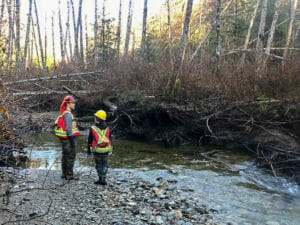
In the years since its creation, the program’s focus has grown. Today the Guardians not only monitor their territories, but they have also taken on their ancestral responsibility of caring for their lands, waters, wildlife, and food sources for the benefit of future generations.
“The Guardian program, and the stewardship of our land and the protection of our territory is paramount,” says Chief Councillor Powell. “Since we don’t live in the territory, they are our eyes and ears on our lands and waters.”
The work of the Guardians is varied, ranging from communicating the Nation’s stewardship principles, history, and culture to visitors, to implementing those same principles through diverse stewardship initiatives.
Our young people are getting to connect with the wildlife, they’re getting to connect to the land, they’re getting to connect to the ocean.
“Our Nation has a vision of being strong, self-sufficient, and sovereign. The Guardians are a vital part of that,” said Sumner in a 2018 article about the program.
Of the Guardians themselves, Chief Councillor Powell says the role is critical to the future of Mamalilikulla First Nation. “Our young people are getting to connect with the wildlife, they’re getting to connect to the land, they’re getting to connect to the ocean. They see fantastic things that make them more committed to their job and motivated to secure and conserve what is there now,” he says. “They’re going to end up being the ones that motivate the growth of these programs, because they’ll know how important they are having been out there and done the work.”
In the case of Guardian manager Jake Smith, that motivation is clear and present. Smith was hired by Sumner in April 2018 to work full-time year-round for the Guardians. In the winter, along with the Marine Coordinator Frances Roberts, Smith develops a work plan for the year, applies for funding, and organizes Guardian training for the off season. In the summer months, he oversees a crew of four other Guardians, makes sure deliverables are met, and monitors activities in the Mamalilikulla First Nation traditional territory.
For Smith, the job of Guardian manager is inextricably linked to his cultural responsibilities. “As a hereditary Chief, it’s our job to protect the lands and resources, and hold this at a high-level of respect,” he says.
As the name implies, hereditary Chiefs are those who inherit the title and responsibilities according to the history and cultural values of their community. Their governing principles are anchored in their own cultural traditions. Hereditary chiefs carry the responsibility of ensuring the traditions, protocols, songs, dances of the community, which have been passed down for hundreds of generations, are respected and kept alive. They are caretakers of the people and the culture.
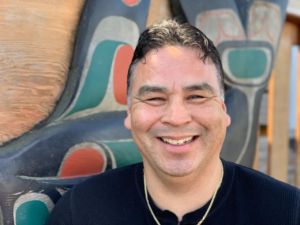
Some of the many projects Smith and the other Mamalilikulla Guardians are conducting include:
- Pre- and post-logging surveys
- Large cultural and culturally modified tree surveys
- eDNA surveys
- Geographical response surveys
- Stream monitoring
- Grizzly bear monitoring
- Kelp and eel grass data collecting and monitoring
- Archeology assessments
Smith is proud of the work he and his small team have accomplished over the last years, but he knows there’s much more that needs to be done. “People need to really open our eyes and look around, because there’s so much human impact that we do in the environment,” he says.
Return to ‘Mimkwa̱mlis and a Growing Tourism Connection
In his four years as manager, Smith has spent a great deal of it out on the water with his crew. “I love to be hands-on, teaching and passing on my knowledge to other Guardian members,” he says. Until 2019, the Guardians operated out of nuxda’ma Compton Island, taking day trips to ‘Mimwkamlis Village Island, gwaxdłala Lull Bay, and ‘nalaxdłala Hoeya Sound.
Between 2012 and 2015, Mamalilikulla First Nation used their Coast Funds economic development funding to construct ecotourism infrastructure on nuxda’ma Compton Island, including four big-house style cabins, boardwalks, a cook house, bathroom facilities and storage sheds. The infrastructure provides an excellent base for Mamalilikulla Guardians to operate from and hold gatherings with other Nation’s Guardian departments as part of the Ha-ma-yas Stewardship Network.

In 2019, the Guardians installed a new dock and a small Guardian base camp on ‘Mimkwa̱mlis Village Island, which is where they currently operate of, with investments from their endowed funds with Coast Funds. The new base is centrally located within the territory and enables the Guardians to travel to remote locations as well as the busy visitor destinations.
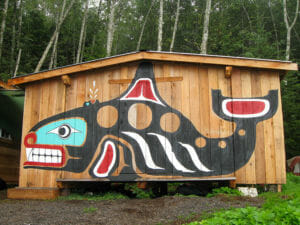
The Nation hopes to renew their eco-cultural tourism hub at nuxda’ma Compton Island, a project that is intricately connected to the Guardian’s work. The island is visited frequently by kayakers and marine recreationalists, though no financial benefit is returned to the Nation, and in some cases, Chief Councillor Powell says, has “infringed into our areas and actually disrupted, destroyed areas that are considered sacred areas in our territory.”
Marine Coordinator Frances Roberts says much of the negative impact on the Nation’s territory could be prevented by maintaining full-time Guardians year-round. “With people camping out there we’re constantly finding that people are lighting fires right beside burial grounds, and stuff like that…I’d love to see our Guardians out monitoring the territory year-round,” she says.
By growing the Nation’s access to self-determined stewardship finance, the Guardians would ensure enhanced management of nuxda’ma Compton Island, allowing the Nation to in turn, benefit from eco-tourist visitors. Tourism is already a factor in much of the territory and throughout the region, but the Nation has limited capacity to monitor tourist activity, let alone offer guided tours or accommodations. In the future, the Nation would like the Guardians to play an interconnected role with tourism, including ensuring that visitors respect cultural sites, following the rules set out, and pay the fees for access to and use of the territory.
Monitoring the Marine Health of the Broughton Archipelago
Guardian Watchmen are often referred to as their Nation’s “eyes and ears” on the territory. The term refers in large part to the monitoring work they undertake. The rich waters, diverse wildlife, ancient forests, and mild coastal climate of the Broughton Archipelago means the region has attracted increasing levels of resource development, recreation, and tourism over the last century and a half.
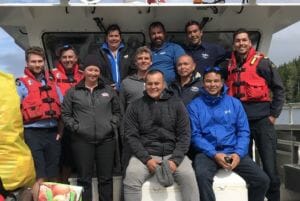
During their patrols, the Guardians are tasked with monitoring industries such as logging, commercial fishing, and aquaculture, as well as recreational activities sport fishing, whale watching, and kayaking. These myriad activities have created pressures on the region that the Guardians are often responsible for addressing.
Smith would like to see greater cooperation with industry and the various levels of government to ensure the region is appropriately cared for. “We need to protect our ecosystem,” he says. “It is crucial to expand on existing management measures, to better address impacts from fishing and habitat loss while acknowledging shifting conditions due to climate change. Each of us holds a piece of the solution for these crises.”
Each of us holds a piece of the solution for these crises.

In addition, Mamalilikulla First Nation is working to expand the Guardians’ authority to enforce observed infractions and to uphold Mamalilikulla stewardship values throughout the territory. “One of the biggest shortfalls of the program is that they don’t have the authority to enforce,” says Chief Councillor Powell. “It’s all very well and fine that we’re stewards of our land and we can help around conservation, but if we can’t say ‘cease and desist or else we will fine you’ then we don’t really have the power to motivate change where it is most needed.”
Because the Guardians lack authority to enforce garbage and debris removal for industrial and recreational users in their territory, Smith’s team is often left to clean up behind them, dedicating precious human resource capacity to do so. “Everywhere we go our Guardians are always picking up garbage when we’re out in the territory,” says Smith.
And it’s not just a few bags of trash here and there. In spring 2020, the Mamalilikulla Guardians organized a clean-up to remove abandoned derelict boats, drums and batteries in Broughton Archipelago. Smith points out that the debris can be a hazard to food security in many places, often being on clam beds and in front of rivers where salmon spawn. “All I want is for our territory to be clean and healthy for our marine life because everyone will benefit from the ocean’s food sources,” said Smith.
That dedication to the health of the marine ecosystem runs through many of the Guardian undertakings. Scientific monitoring and data collection forms a large part of the Guardian work each year. One of the key areas of focus for the Nation has been the monitoring of loxiwe clam gardens, scattered throughout the beaches of their territory.
In 2009, Mamalilikulla partnered with neighbouring Da’naxda’xw Awaetlala First Nation to undertake a traditional clam garden rejuvenation project. The project, which was financed with $287,200 from the Nations’ economic funding with Coast Funds, restored eight clam gardens throughout the Nations’ territories.
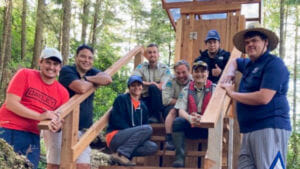
Today, the Guardians continue monitoring of loxiwe clam gardens in the territory and gathering data about health and harvest of the shellfish. Other marine focused projects include water chemistry analysis in partnership with Hakai Research Institute, kelp and eelgrass surveys as part of the Marine Plan Partnership, and geographic response planning in partnership with the Coast Guard and BC Parks.
Eelgrass and kelp are critical habitat for a number of marine species, from salmon and herring to rockfish and seastars. Eelgrass is also an important ally in the fight against climate change, as it sequesters a high level of carbon. Both the kelp and eelgrass projects offer insights on climate change and its impact on critical near-shore habitats.
Through their stewardship vision, Mamalilikulla First Nation outlined an increased role for monitoring of their territory. On top of the work noted above, the Nation aims to develop an emergency response team to respond to any crises that develop in their territory, like an oil spill. Roberts notes the Guardians have spent time on the water with Western Canada Marine Response Corporation (WCMRC) preparing for an emergency like an oil spill.
“We’ve done a lot of training on that. And two years ago we went out and marked all the different sites, their coordinates, the tides, and the water heights so we can know what we want to protect if there is an oil spill,” Roberts says. “Now we’re actually going out with the Guardians to run through the exercises like putting the booms out.”
The Mamalilikulla Guardians also aim to have first right of refusal for any environmental monitoring work taking place in the territory. The Guardians and stewardship staff would work with third parties working in the territory to ensure it is taking place in a culturally appropriate way and that information is shared with the Nation.
Working to Restore the Health of Salmon Populations
“What if salmon were to vanish from our entire river systems completely? The well-being of our communities is deeply rooted in the health of our watersheds, and the fish within them.” – Jake Smith, Guardian manager, and Mamalilikulla hereditary Chief

One of the biggest concerns Jake Smith has relates to the health of salmon populations in Mamalilikulla territory. A 2020 report into abundance of 94 distinct populations of Pacific salmon in the Broughton Archipelago concluded that most rivers in the region have low-to-moderate abundance.
‘Nalaxdłala Hoeya Sound and gwaxdłala Lull Bay are two areas within the territory of critical importance for salmon. In the years since becoming Guardian manager, Smith has interviewed Mamalilikulla Elders and hereditary leadership, as well commercial fisherman, to discuss historic populations and best stewardship practices for salmon. “[The fishermen] used to bring their seine boats right up there to fish outside Lull Bay—and now there’s absolutely nothing,” he says.
The salmon is an ecological and cultural keystone species, intimately connected to First Nations’ well-being and the well-being of the many species within their territory.

Richard Sumner says the low salmon numbers are “not a natural thing” and points to human activity such as deforestation, fish farms, overfishing, and climate change for the reduced numbers. Chief Councillor Powell agrees: “There’s a lot of logging and other activity that goes on in our territory and it really does change the habitat,” he says. “Not only does it change the forests, but it changes the rivers.”
The Guardians are undertaking many projects and programs to encourage a rebound in the salmon populations, and the protection of the many species that rely on them. A large part of the focus for current and future projects are in ‘nalaxdłala Hoeya Sound and gwaxdłala Lull Bay. The Nation’s long-term vision for the area is to restore salmon populations, to create an intact natural ecosystem to support the cultural, sustenance and livelihood needs of Mamalilikulla people, and to establish protected and conserved attitude where ever our territory is concerned.
“We really want to prioritize working on the watersheds, getting more data about them, and getting salmon back in the streams,” says Roberts.
We as First Nations people represent all of the animals on land and ocean in our sacred ceremonies when we potlatch. If they die then so does our culture. That’s why it’s so important to me to protect everything.
Additionally, the Guardians are currently working through the Indigenous Monitoring and Inspection Program (along with ‘Namgis and Kwikwasut’inuxw Haxwa’mis First Nations) to oversee the removal of open-net pen salmon farms in the Broughton region and to ensure that sites are remediated adequately. The program provides three years of funding to support Mamalilikulla in this work as salmon farms are phased out and decommissioned in three river systems in the territory. The Nation also aims to undertake salmon enhancement work and possibly develop hatchery infrastructure once the fish farms are removed.
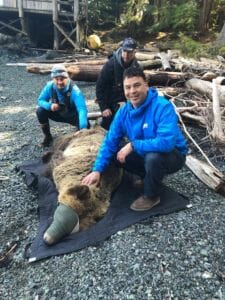
One species particularly hard-hit by declining salmon is the grizzly bear. After years of monitoring the bears in Mamalilikulla territory, the Guardians started to see increasing numbers of malnourished bears. “I’ve seen grizzly bears starving and skinny,” says Smith. “And usually, it’s in September or October when they should be plump and going into hibernation.”
Leadership and members of Mamalilikulla First Nation were extremely concerned when they began observing the starving bears. “We as First Nations people represent all of the animals on land and ocean in our sacred ceremonies when we potlatch,” says Smith. “If they die then so does our culture. That’s why it’s so important to me to protect everything.”
Masks often represent spirit creatures, animals, and myths. When used in the Potlatch ceremonies, dancers take on the personification of the creatures that the masks represent and enter the supernatural world during the dance. The transformation mask often represents the transformation of a human to a mythical creature or animal and vice versa and is held at a high level of respect.
In 2019, Smith led one of the most high-profile activities the Mamalilikulla Guardians have undertaken: feeding salmon to the starving grizzly bears in Hoeya Sound, Lull Bay, and Knights Inlet. Smith reported: “Our Guardians took matters into our own hands. We took 500 pink salmon—donated by the Campbell River Quinsam Hatchery—to feed the grizzlies that we have been monitoring for the last three years. There was no salmon in our watersheds and the bears were starving.”
The following year Smith led the Guardians to relocating one of those grizzlies—a male named Mali, a reference to the Mamalilikulla origin story—from Hanson Island to Hoeya Sound, traditional summer habitat of the bear. Following relocation, the bear was shot by a homesteader in Knights Inlet. Smith doesn’t regret moving the bear but points out that such efforts may fail without simultaneously addressing the lack of food for the bears, including restoring the health of salmon populations.
The Guardians also recently embarked on a restoration and research project with bear biologist Wayne McCrory. The team spent a week out in the territory learning how to capture DNA samples, place wildlife cameras, and learn about the type of food and habitat bears need to maintain a healthy population.
“We hope to be able to establish a healthy bear population and healthy river population,” says Chief Councillor Powell. “That kind of work is important, where the guardians have an opportunity to not only be stewards of the land, but to actually make life better for the wildlife.”
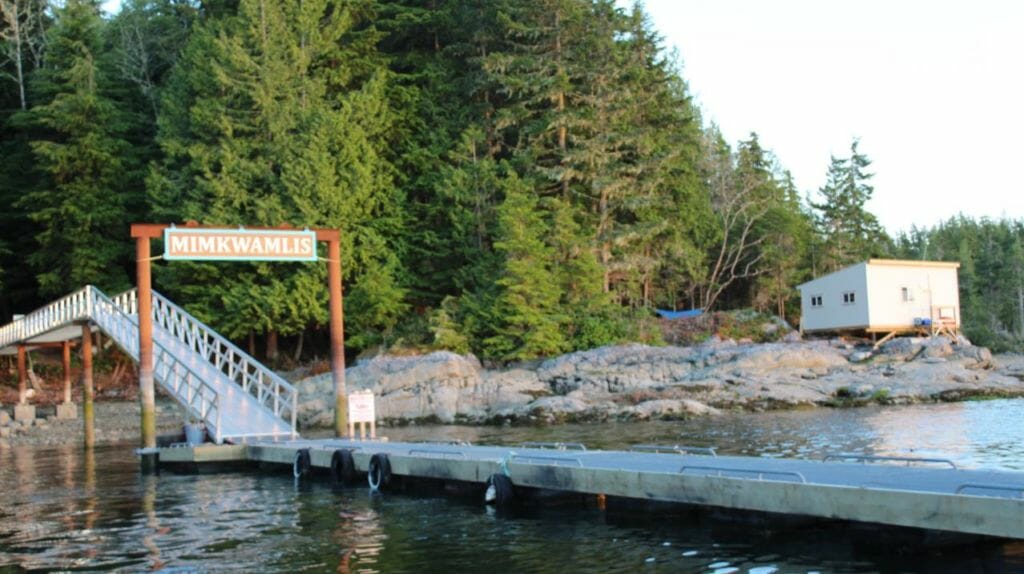
Working as a Part of Ha-ma-yas Stewardship Network and Protecting Cultural Sites
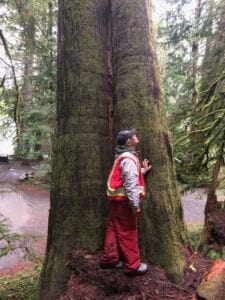
Some of the Guardian’s work is conducted as a member of the Ha-ma-yas Stewardship Network. The Network was established by Na̲nwak̲olas Council, which consists of five member Nations: Mamalilikulla, Tlowitsis, Da’naxda’xw Awaetlala, Wei Wai Kum, and K’ómoks.
The Network builds capacity and professionalism within each of the Nation’s Guardian programs and helps finds program funding. Each year priorities and budgets are set, and a Mamalilikulla Guardian work plan is created to care for their territory.
Scott Harris is the stewardship coordinator for Ha-ma-yas Stewardship Network and has worked closely with Smith over the last four years. “It’s been a real pleasure working with Jake,” says Harris, whose job is to ensure that the five member Nations of Na̲nwak̲olas Council are mobilized and have the resources to carry out their Guardian programs each year.
The Guardians are a key part of resource management and decision making for their Nations.
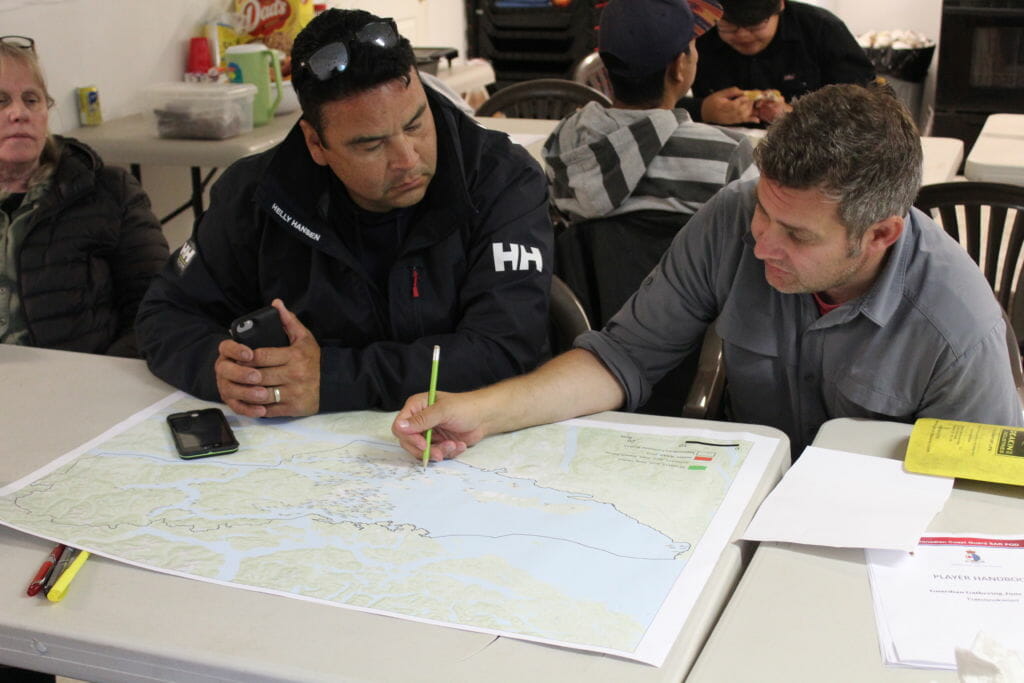
“We work together to support the Guardians to operate at a professional level that will earn respect from other agencies, industries, and governments,” says Harris. “The Guardians are a key part of resource management and decision making for their Nations.”
Each year, the member Nations of the Ha-ma-yas Stewardship Network attend gatherings where they share knowledge, resources, and undergo shared training. These trainings differ from year to year and can focus on refreshing core competencies and/or introducing new skills.
Na̲nwak̲olas Council also provides a centralized referrals management process for member Nations, including Mamalilikulla. Na̲nwak̲olas staff prepare research briefs for Mamalilikulla leadership to support dialogue and feedback regarding resource development decisions. The research is based on data collected and research conducted by the Guardian programs, marine and land use plans, and traditional use data.
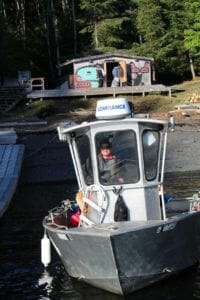
One of the most significant projects undertaken as part of Ha-ma-yas is the archeological assessment of sites throughout the Mamalilikulla homelands. Many sites of cultural importance are at risk of disturbance by human interference and natural forces. One such site is known as the Chief’s Bath. Smith says that according to oral history, there was once 20 burial boxes at the Chief’s Bath, but now only four remain.
The Guardians have been working over the last three years to protect the Chief’s Bath, and other sites of significance. The sites are popular with tourists who camp in these areas and have sometimes disturbed the burial boxes. “We have signs up, and we have cameras, but people will just pick up bones and…they’ll do things they shouldn’t be doing,” says Roberts. “We don’t always have the manpower to prevent it, and we we’re not out there year round.”
The Guardians regularly engage the public, teaching them about respectful behaviour and use of the territory, and are protecting the most vulnerable cultural sites. The Guardians, with support from Na̲nwak̲olas and the Ha-ma-yas Stewardship Network, are building a database of cultural and archeological data that can be utilized in resource management decision making.
Understanding and protecting this historic aspect of the Nation’s culture is critical to cultural well-being says Smith. “When we hire a Guardian, I try to educate them about the culture, because the culture is so important.” Smith has a trove of research he shares with staff who are interested. “How can our people be proud of who they are and where they come from if they don’t know anything about our culture? That’s why it’s so important to share with our people, so we can have that connection to the land.”
Looking to the Future: Growing Mamalilikulla’s Guardian Program with Increased Sustainable Stewardship Finance

Despite the immense undertakings the Guardians oversee each year, both Harris and Smith readily point out that Mamalilikulla First Nation would like to do much more in their territory. The list of issues to confront within the territory seems insurmountable at times: protecting it from impacts of industrial-scale logging, over-fishing, fish farms, the threat of oil spills, increased recreation and tourism, climate change impacts, and more.
“It’s necessary for us to have those stewards of the land monitoring everything and taking data,” says Roberts. “And we need to be managing our own resources the way First Nations people always have.”
The list may seem daunting, and the Guardians would like to address all of them. Yet, there are a number of challenges that stand in their way, the most pressing of which is access to adequate, sustainable stewardship finance. Smith, Roberts, and Harris work together each year on the Mamalilikulla Guardian budget and scheduling. They must consider many complex factors, from the number of boat trips required, to how much food and equipment will cost, to even considering when the tides are right for getting the Guardians out on the water.
Much of the Guardian program is funded through discrete, project-based grants. Despite supporting Guardian programs and stewardship endeavours to make ends meet and undertake important conservation work these funds are not self-determined and can detract from Mamalilikulla’s ability to engage in their prioritized stewardship activities.
“In a lot of ways we tend to prioritize last the things we want to do because…there are so many deliverables that come along with the funding,” says Roberts.
If we can increase Mamalilikulla’s stewardship endowment with Coast Funds, it would…really allow the Nations to settle in and establish their Guardian programs.
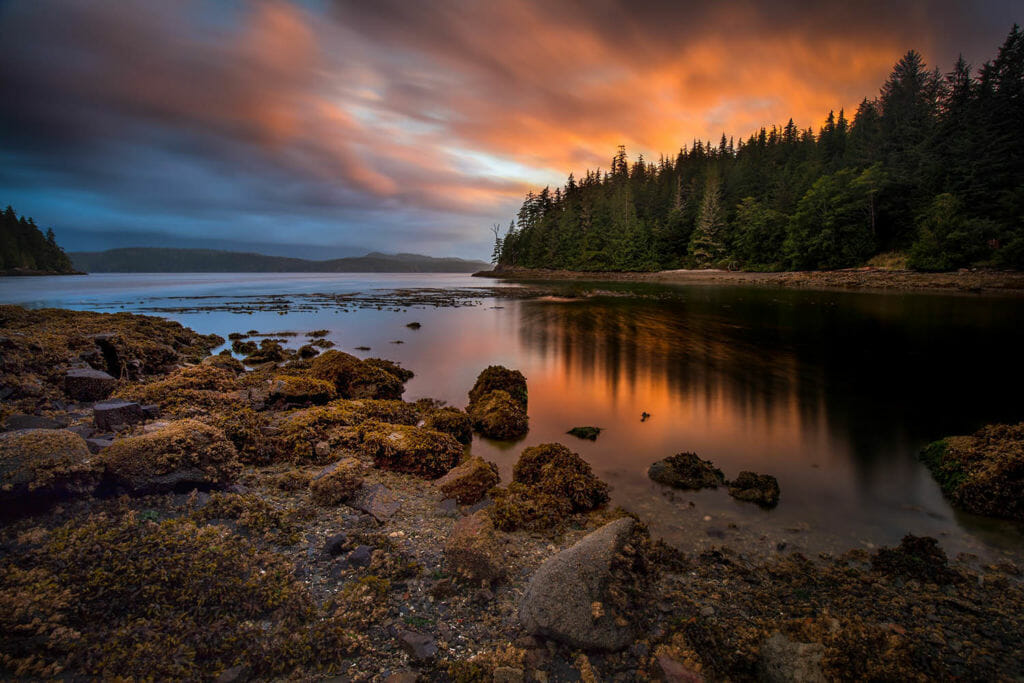
As it stands, the program often must be reactionary rather than proactive. “If we can increase Mamalilikulla’s stewardship endowment with Coast Funds, it would just take a little bit of the pressure off having to chase funding with strings attached,” says Harris. “It would really allow the Nations to settle in and establish their Guardian programs.”
Harris says he and Smith often must wait until late spring to be able to finalize their budget before they can plan their Guardian season. “It’s short-term planning, we don’t always get a chance to think about next year or the year after that,” says Harris.
To build out a longer-term plan, Harris and Coast Funds worked with Mamalilikulla staff and leadership to document the Nation’s 10-year stewardship vision. The vision outlines a clear direction for the Nation’s stewardship department and the Guardian Watchmen program.
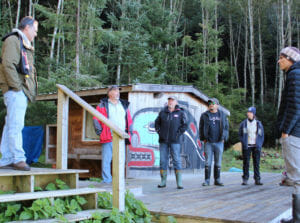
One of the biggest focuses of the plan is to increase the capacity of the Guardian program. “It’s a challenge for all of the First Nations communities in this region to support stewardship efforts and to create well-paid, meaningful employment for our people,” says Richard Sumner. The current Guardian program includes Jake Smith as the full time, year-round program manager, supported by four seasonal Guardians. “That’s not enough in terms of the work required to be done or providing sustainable employment,” says Sumner.
If the Nation had access to enough finance to fund their program annually, they would be able to plan many years down the road, and could fund many more full-time staff. “I would really like to see all the Guardians out there working year round,” says Chief Councillor Powell. “It’s obvious that until we have a physical and ongoing presence, until we have established sites where we have people working year-round, we’re not going to have those eyes on our territory, we’re not going to have the ears.”
Roberts agrees: “It would great to keep our Guardians on staff all year round,” she says. “There’s enough training they could do in the off-season, and it would be nice for them to get out in the territory to check what’s going on.”
If people recognize the success that we have on the coast, with these Guardian programs, they’ll see that there is the possibility to save what we have left and to pass it on to our young people. We can pass on the love and the connection, that is so incredibly crucial to our success as First Peoples.
In order to build the Mamalilikulla Guardian program to its full potential, funding is needed to support two additional year-round positions and six seasonal roles. The vision also outlines the development of a Junior Guardian program which would create an opportunity to mentor and train youth into the Guardian role. “I’d like to see the Guardians being financed and resourced in a way that means that they can look at their program as a year-round career,” says Chief Councillor Powell.
Smith is the first to acknowledge the challenges he faces in his role, and the ongoing struggle to achieve success, “Sometimes it seems like everything you do, you have to fight for,” he says, but he is noticing positive change and that is what keeps him motivated. Guardian programs, he says, are finally starting to get the recognition they deserve for the critical work they are leading. “The government is finally taking it serious, and that’s good because we need that. We need that help and support.”
Chief Councillor Powell sees the work of the Guardian providing benefits far beyond the borders of Mamalilikulla territory. “At this time, especially with the advent of climate change, and the overharvesting of fishing and other resources, I think the Guardian program is a vanguard for the kind of work that needs to be done worldwide,” he says. “If people recognize the success that we have on the coast, with these Guardian programs, they’ll see that there is the possibility to save what we have left and to pass it on to our young people. We can pass on the love and the connection, that is so incredibly crucial to our success as First Peoples.”
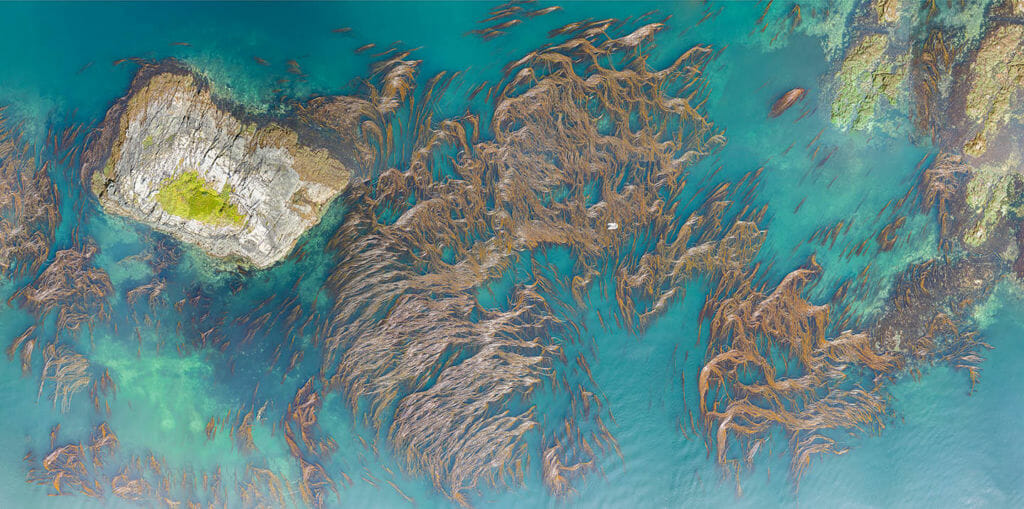
Lessons Learned
Build Bridges, Don’t Burn them
Jake Smith isn’t shy talking about the challenges he faces from working with different levels of government, agencies, and organizations. But he’s learned there’s more benefit that comes from working together than playing the blame game. “You can’t burn bridges,” he says. “You really have to work with people.”
Smith says he can get frustrated when he finds government officials unwilling or unable to act on problems that arise, but he’s learned to channel his energy elsewhere. He says there’s always someone who’s willing to support the Guardian work, he just has to find them: “I’ve reached out to every organization, every company, every non-profit to help make a positive impact to protect our ecosystem.”
Uplift Everyone and Share Knowledge Where You Can
“Take a moment and imagine what it would look like, if we worked together?” Smith asks. He says that solutions may exist for the problems he sees in his own territory, but they don’t follow discrete borders that you might see on a map. He’s learned over his years that there is great power that comes from sharing wisdom and sharing resources: “We could all share and learn from one another, building capacity and reconciliation.”
Smith shares what he can through Guardian Watchmen gatherings, and by teaching his new staff about Mamalilikulla history, culture, and the territory. “I think it helps bring them into the picture and be part of that,” he says. “So they have a better vision and a better understanding of everything.”
Don’t Be Afraid to Speak Up
One of the most important lessons Smith shares, is the power of speaking up. “It’s a tough skill to learn,” he says. “We need to encourage and give people the opportunity to speak up..”
Smith has done a compelling job of speaking up on behalf of the Nation and reporting publicly what he sees throughout the territory. “I reach out to all those newspapers to help the Nation get the word out globally. If we don’t share it, how are people supposed to know what’s going on?”
Respecting Protocols
Guardian Manager Jake Smith offers the following guidance for individuals and organizations working with Mamalilikulla First Nation and the Mamalilikulla Guardians:
“You may have heard the term protocol in relation to working with Indigenous people. The term protocol includes many things, but overall it refers to ways of interacting with Indigenous people in a manner that respects traditional ways of being.
Protocols are not just “manners” or “rules” – they are a representation of a culture’s deeply held ethical system. They also have highly practical applications that may have arisen in a pre-contact context but still apply today. Protocols differ vastly from one Indigenous culture or community to another, and they can be highly complex and multi-layered.
Coming to understand and practice protocols appropriately is a lifelong learning process even for Indigenous people growing up within their culture. Following protocols is a significant sign of respect and awareness. It shows that you are taking the time to learn about Indigenous cultures and are challenging the often-unconscious bias that everyone should interact in the way that mainstream settler culture dictates.
Through following protocols, you can build stronger relationships with Indigenous communities and learn about different ways of interacting. As a non-Indigenous person who is just learning about protocol, there are a few simple things you can do that are generally common to Indigenous cultures.
These include:
- Acknowledging the traditional lands on which you are situated. If you do not know the area, ask someone who knows. Acknowledging the traditional lands is generally done at the beginning of a meeting, but some may wonder why.
- Doing so acknowledges that you recognize that you’re on the land of a Nation that has had a relationship since time immemorial with that land. It is a sign of respect and recognition, and you can’t go wrong with respect and recognition. You are acknowledging the ties the descendants of those First Nation People have to the land, its importance to their culture, ceremonies, and traditions.
- Acknowledgement is a reflection and expression of gratitude that recognizes the Indigenous lands
Beyond these practices, you should be ready to engage in a lifelong learning process. As protocols vary widely between and even within Indigenous cultures, they are not something you can learn about by taking a course or reading a list. They are learned through relationships. Therefore, it is important to find people who you trust to support you as you learn about protocols.”
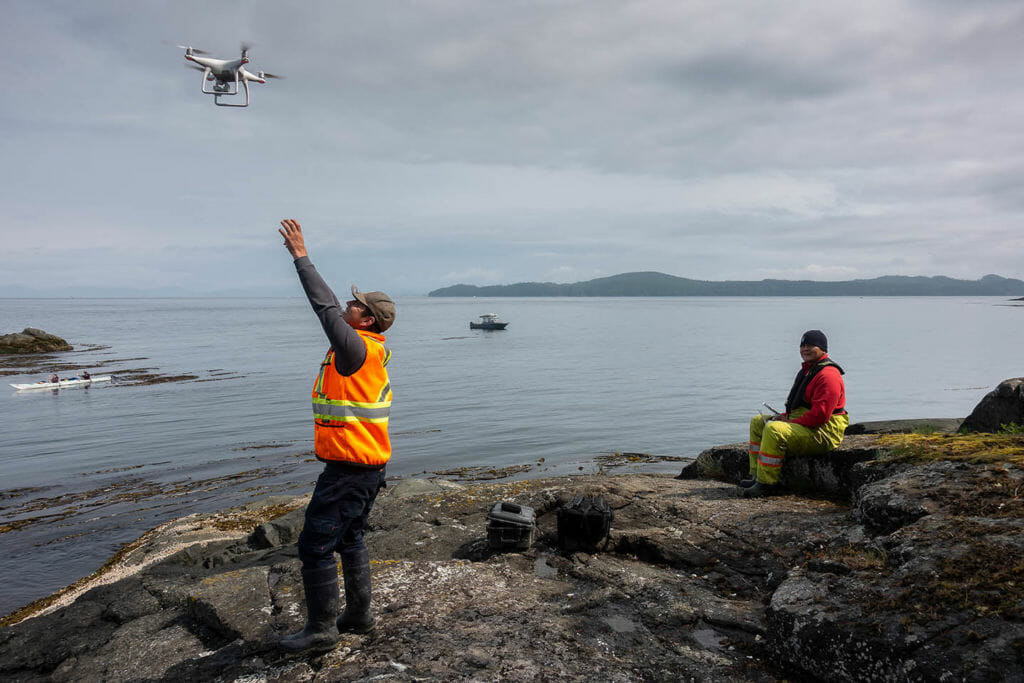
Economic Outcomes
Mamalilikulla First Nation have invested significantly in infrastructure to benefit their Nation’s stewardship efforts and economic development undertakings. The tourism infrastructure installed at Compton Island has enabled the Guardian program to access their territories more easily for monitoring and patrols. The Guardians also built a dock and cabin at Village Island to allow easy access.
In 2015, the Nation also purchased a boat to support its Guardian Watchmen program (and at the time its ecotourism initiative). The vessel purchase is a significant one for the Guardians, without which they would not be able to conduct their stewardship operations.
Both those infrastructure projects support economic development through ecotourism in Mamalilikulla territory, something the Nation hopes to continue to develop.
Mamalilikulla’s stewardship and economic investments through their Coast Funds’ allocation have also supported 18 partnerships. These strategic partnerships enhance the capacity of the Nations’ stewardship efforts and facilitate knowledge-sharing and collaboration throughout the region.
Cultural Outcomes
The cultural benefits of the Guardian Watchmen program are immense. For the Mamalilikulla First Nation, stewardship and culture are inextricably linked. “When we host a Potlatch, we represent every single animal on the planet,” says Smith. “But what’s the point of representing them and respecting them in our big houses, if we don’t do it on the outside too? That’s a part of why we’re protecting them.”
The Guardians are supporting language revitalization by installing signage on ‘Mimkwa̱mlis Village Island and, during the Guardians’ inaugural year, traditional names throughout the territory were catalogued and added to maps.
The program does a great deal to ensure access to traditional foods for Mamalilikulla members. Strengthening access to traditional foods such as salmon, shellfish, and more ensure health, food security, and in turn improve species’ abundance in the region.
One of the biggest cultural impacts the program has is ensuring the protection, longevity, and mapping of cultural assets such as culturally modified trees, pictographs, burials, and other archeological sites. By locating, monitoring, and recording information about cultural assets, the Mamalilikulla Guardians are helping protect these sacred places for future generations.
Environmental Outcomes
“Our Mamalilikulla guardians have worked hard to protect our land and resources, we’ve dedicated and committed our time to be out in the territory to collect the valuable and important data, so we can help make a healthy and positive change to our ecosystem,” says Guardian manager Jake Smith.
The Mamalilikulla Guardian program contributes to a long list of positive environmental benefits. The Guardian program spends an average 150 days each year monitoring 287,901 hectares of their territory. They completed research on important marine species including shellfish (clam, cockles, crab, prawn), eelgrass, kelp, salmon; and terrestrial species like grizzly bears, black bears, and gray wolves. Research and monitoring of diverse species helps ensure their health and longevity.
The program has also undertaken significant efforts to ensure the health of Pacific salmon populations in their territory, including watershed restoration work in gwaxdłala Lull Bay, and ‘nalaxdłala Hoeya Sound.
“Being able to protect what we have left is one of the greatest opportunities I think we’re afforded,” says Chief Councillor Powell.
Learn more about Guardian Watchmen and regional monitoring outcomes.
Social Outcomes
The Mamalilikulla Guardian Watchmen program employs Jake Smith as its full-time manager, as well as four seasonal Guardian staff. The work is a good one for building pride, self-esteem, and cultural knowledge. “Anyone doing this job is someone who isn’t scared of working hard,” said Richard Sumner in a Na̲nwak̲olas article about the program. “There is also a lot of pride and self-esteem that comes with being a Guardian.”
Chief Councillor Powell also says the Guardian Watchmen program is creating the next generation of Mamalilikulla who are motivated to protect and conserve their homelands. “Land-based learning—being able to connect with the land and the ocean in a really meaningful way—is the most sustainable wellness tool that we have in our entire toolkit,” he says. “I think that’s an amazing advantage that our young people are getting to connect with the wildlife, they’re getting to connect to the land, they’re getting to connect to the ocean. They see fantastic things that make them more committed to their job and motivated to secure and conserve what is there now.”
The Guardian program is empowering staff through education, training, and professional certifications. Over its years of operations, investments in the Guardian program and related economic development have supported 288 training days for 25 people. 54 certifications have been received through those same investments including in Wilderness First Aid, Search and Rescue, Safety and Marine Response, Small Vessel Operator Radio, Drone Training, and extensive survey training such as eelgrass, seals, clams, crabs, and prawns.
In 2021, the four new Mamalilikulla Guardians had just completed the Stewardship Technicians Training Program offered through Vancouver Island University in partnership with Na̲nwak̲olas Council. “It was great,” says Smith. “They got a head start on what’s to come out in the field there.”
Between 2009 and 2020, Coast Economic Development Society and Coast Conservation Endowment Fund Foundation approved funding to Mamalilikulla First Nation for $1,008,343 for nine stewardship, conservation, and economic development projects.
Partnerships
- Na̲nwak̲olas Council
- Ha-Ma-Yas Stewardship Network
- Coast Funds
- DMT Fisheries Society
- Coastal First Nations
- BC Parks
- Ministry of Environment & Parks
- Ministry of Forests, Lands, Natural Resource Operations and Rural Development
- Ministry of Transportation and Infrastructure
- Canadian Coast Guard
- Hakai Institute
- Inlailawatash
- Kenmore Air
- Marine Plan Partnership
- Mowi ASA
- North Vancouver Island Aboriginal Training Society
- Nuka Research & Planning Group, LLC
- Sauder S3i
- Tide Rip Tours
Online Resources
- Mamalilikulla First Nation
Mamalilikulla First Nation website - Invest in Stewardship
Overview about Mamalilikulla First Nation fundraising with Coast Funds for stewardship finance - Broughton Archipelago Marine Provincial Park
Information about Broughton Archipelago - Na̲nwak̲olas Council
Na̲nwak̲olas Council website - Ha-ma-yas Stewardship Network
Information about Ha-ma-yas Stewardship Network - About Mamalilikulla
Mamalilikulla origin story - They Came for the Children
Truth and Reconciliation Commission, 2012 - Potlatch Ban
Umista Potlach Ban information - Stepping Up to Be a Guardian
Na̲nwak̲olas Council, April 2018 - Structure of the Funds
About Coast Funds’ fund structure - Conservation Project Funding
About conservation finance for First Nations projects - Economic Development Funding
About funding for First Nations’ economic development - First Nation’s guardians ‘take matters into their own hands’ and organize environmental clean-up
Campbell River Mirror, May 2020 - Eelgrass and kelp mapping and monitoring
Mid-Vancouver Island Habitat Enhancement Society, 2019 - The status of Pacific salmon in the Broughton Archipelago, northeast Vancouver Island, and mainland inlets
Salmon Coast, 2020 - Sockeye returns plunge in B.C., official calls 2019 'extremely challenging'
CBC, August 2019 - Salmon, A Keystone Species
Pacific Wild - BC First Nation feeds hungry grizzlies 500 salmon carcasses
CBC, October, 2019 - Indigenous input helps save wayward grizzly bear from summary killing
The Guardian, April 2020 - Indigenous Protected and Conserved Areas
ILI Nationhood - First Nations to oversee fish-farm phase out in Broughton Archipelago
Times Colonist, September 2019 - Back to the Future
Na̲nwak̲olas Council, November 2018 - Present and Accounted For
Na̲nwak̲olas Council, January, 2017 - Not Just In the Job: On the Job
Na̲nwak̲olas Council, April 2018
Published On August 31, 2021 | Edited On February 26, 2025
